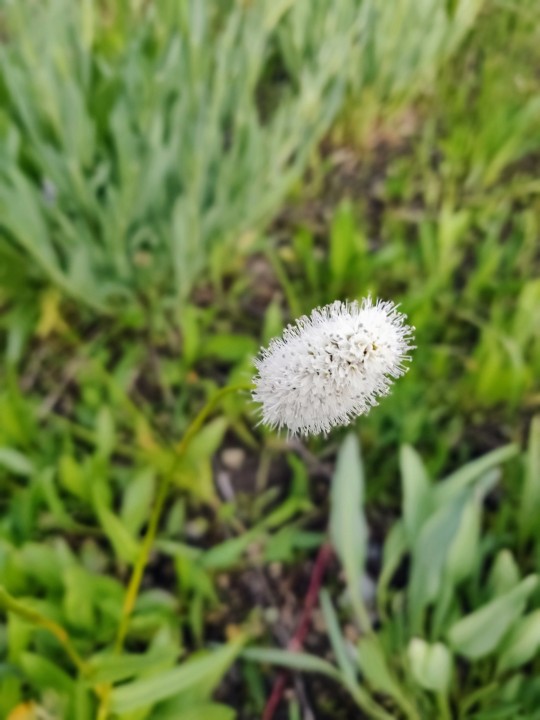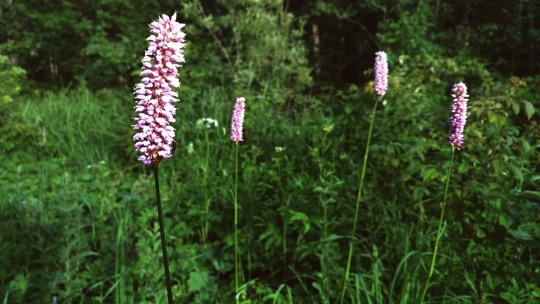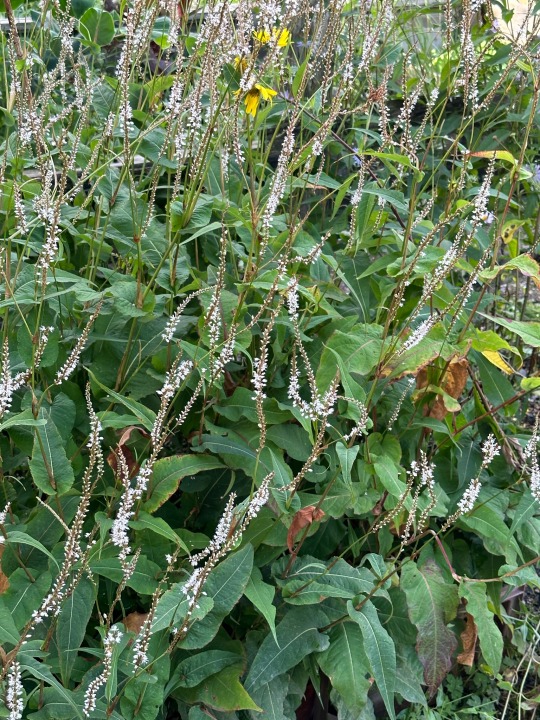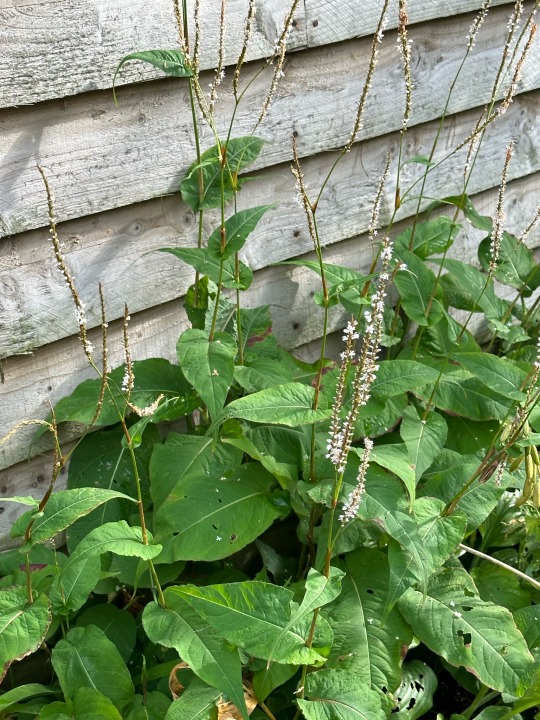#bistorta
Explore tagged Tumblr posts
Text



Plant of the Day
Thursday 23 November 2023
The clump-forming, vigorous perennial Bistorta amplexicaulis 'Alba' (bistort, persicaria) quickly makes excellent groundcover in sun or partial shade. It favours damp soil and from mid-summer to early autumn produces slender spikes of tiny, white flowers which attracts pollinators.
Jill Raggett
#Bistorta#Bistort#persicaria#white flowers#damp garden#plants#horticulture#gardens#garden#herbaceousperennial#Sussex
52 notes
·
View notes
Text

Bistorta amplexicaulis / Red Bistort at the JC Raulston Arboretum at North Carolina State University in Raleigh, NC
#Bistorta amplexicaulis#Bistorta#Polygonaceae#Red Bistort#Bistort#Mountain fleece#Plants#Flowers#Nature photography#photography#photographers on tumblr#Jc raulston arboretum#north carolina state university#Ncsu#nc state#Raleigh#Raleigh NC#north carolina#🌺🌻#Persicaria amplexicaulis#Persicaria
3 notes
·
View notes
Video
Camissonia bistorta by Arlene Schag Via Flickr: Southern California - Ramona, Camissonia bistorta growing in full sun near Cedar Creek Falls, May 2010. Small population. Chaparral / Riparian habitat, a beautiful native in an area where most have have been crowded out by foreign plants and introduced weeds.
#Camissonia bistorta#4petals#wildlflower#Ramona#California#SoCal#Cedar#Creek#trail#native#identify#nature#name#red dots#short#small#outdoor#invasive species#introduced species#Inaja Indian Reservation#conservation#flores#flickr#Westcoast Wildlife
0 notes
Text
Top to bottom, left to right:
Geum triflorum / Prairie Smoke
Lithophragma glabrum / Bulbous Woodland Star
Allium aaseae / Aase's Onion
Bistorta bistortoides / Smokeweed
Mertensia ciliata / Mountain Bluebells
Senecio integerrimus / Tall Western Groundsel
Viola praemorsa / Canary Violet
Wyethia helianthoides / White-Head Mule's Ears








Some Idaho wildflowers
#Geum triflorum#Prairie Smoke#Lithophragma glabrum#Bulbous Woodland Star#Allium aaseae#Aase's onion#Bistorta bistortoides#Smokeweed#Mertensia ciliata#Mountain Bluebells#Senecio integerrimus#Tall Western groundsel#Viola praemorsa#Canary Violet#Wyethia helianthoides#White-Head Mule's ears#Wildflowers#Flowers#Plants#Plantblr#Plant identification#taxonomy
61 notes
·
View notes
Text



Bistorta amplexicaulis formerly Persicaria amplexicaulis (mountain fleece var: "Firetail") and Bombus impatiens (common eastern bumblebee)
Our old Persicaria "Firetail" is well into it's third month of blooming but it's still getting plenty of attention from the local pollinators. This Persicaria has an unusually long flowering season for a perennial which tend to have a much shorter season than annuals. I understand this species has been adopted by the New Perennial Movement with it's emphasis on gardens with naturalistic settings. If so, then my overgrown and overcrowded, kidney-shaped flower bed is probably a perfect location.
By the way, I know Persicaria amplexicaulis has been recently reclassified as Bistorta amplexicaulis but it will always be Persicaria amplexicaulis to me. Just call me stuck in my ways.
#flowers#photographers on tumblr#persicaria#New Perennial Movement#our garden#fleurs#flores#fiori#blumen#bloemen#Vancouver
92 notes
·
View notes
Text


Змеевик большой, или Горец змеиный, или Раковые шейки, или Змеиный корень (лат. Bistorta officinalis).
Bistorta major.
#русский tumblr#россия#лето#природа#зеленая природа#лес#эстетика леса#загородом#туризм#цветы#змеевик#лесные цветы#жуки#солнечный день#мое фото#russia#summer#nature photography#russiantravel#travel#outdoors#forest#forest aesthetics#wild flowers#bistorta#beetle#beauty of nature#sunny day#my photos#original photography
124 notes
·
View notes
Text
Krog Bistorta Ustarol (introduction)
Krog is a high elf lvl 4 rogue.
Gender: man (he/him)
Age: middle twenties
Height: 189,42 cm
Eyes: blue
Hair: purple
Skin: light (yellowish)
Ideals: really wants to be a hero and help people
Flaws: pride
He is a chaotic good ENFP with horrible charisma. Could easily be identified by his long purple hair and optimistic thinking. Love going on sidequests and is much smarter then he may be perceived.
Fun fact: He has eight siblings where he is the second youngest

7 notes
·
View notes
Text
Terms derived from wort
adder's wort (Bistorta officinalis)
adderwort (Bistorta officinalis)
asterwort (Asteraceae spp.)
awlwort (Subularia aquatica)
banewort
barrenwort (Epimedium alpinum)
bearwort (Meum athamanticum)
bellwort
birthwort
bishop's-wort (Stachys officinalis)
bitterwort
bladderwort
blawort
bloodwort
blue throatwort
blushwort
bogwort
boragewort
bridewort
brimstonewort
brotherwort
brownwort
bruisewort
bugwort
bullwort
burstwort
butterwort
cancerwort (Kickxia spp.)
catwort
clown's ringwort
colewort
common ragwort
coralwort
crosswort
damewort
danewort
dragonwort
dragon's wort
dropwort*
dungwort
earwort*
ebony spleenwort (Asplenium platyneuron)
elderwort
European pillwort
fanwort
felonwort
feltwort
felwort
26 notes
·
View notes
Text
My Garden Flowers Part 7
All photos mine, unedited.












In order of appearance:
181. Early Goldenrod (Solidago juncea) She's named for flowering earlier than most goldenrods, which tend to flower in late summer to fall, but not all! I've seen others flower earlier.
182. Canadian Fly Honeysuckle (Lonicera canadensis) Wasn't expecting her to flower this year, but there she was in the spring! No berries, though, sadly. Maybe next year!
183. Sweetshrub (Calycanthus floridus) Not pictured as she hasn't flowered yet.
184. Burning Bush (Euonymus atropurpureus) Not pictured as she hasn't flowered yet.
185. Mapleleaf viburnum (Viburnum acerifolium) Not pictured as she hasn't flowered yet.
186. Veiny Meadow Rue (Thalictrum venulosom) Not pictured as she hasn't flowered yet.
187. Wild Hydrangea (Hydrangea arborescens) Not blue like the ones that enchanted me the time I visited my aunt in England, but still very nice.
188. Beggar's Lice (Hackelia virginiana) I didn't plant her and don't keep many now that she's popped up. She's a handsome enough plant but her fruits stick to EVERYTHING and leaves can get sickly from time to time.
189. Boneset (Eupatorium perfoliatum) Not pictured as she hasn't flowered yet and probably won't this year because my landlord cut that area. (:
190. Squashberry (Viburnum edule) Not pictured as she hasn't flowered yet.
191. Snowberry (Symphoricarpos albus) Not pictured as she hasn't flowered yet.
192. Virgin's Bower (Clematis ligusticifolia) Not pictured as she hasn't flowered yet.
193. Largeleaf Waterleaf (Hydrophyllum macrophyllum) In my opinion she should be named for her rhizome rather than her leaf. The leaves aren't that big but the rhizomes are huge.
194. Twinflower (Linnaea borealis) Not pictured as she hasn't flowered yet, but she is spreading in a nice little mat.
195. Alpine bistort (Bistorta vivipara) Not pictured as I haven't got pictures yet.
196. Rough Cinquefoil (Potentilla norvegica monspeliensis) I didn't plant this, but she is there regardless! Not pictured as I haven't got pictures yet.
197. Sweetfern (Comptonia peregrina) Not a fern. The leaves are just kind of fernlike.
198. Sundial Lupine (Lupinus perennis) Not pictured as she hasn't flowered yet. New area for her and we'll see if A) she survives and B) if she doesn't turn out to be bigleaf lupine again.
199. Gray Goldernrod (Solidago nemoralis) Not pictured as she hasn't flowered yet.
200. Blue Vervain (Verbena hastata) She gets fairly tall and the flowers come up at the top.
201. Scarlet Runner Bean (Phaseolus coccineus) Another one that's not native to the area and can't survive the winter, but has been grown here in the summers long before colonization.
202. Tall Cinquefoil (Drymocallis arguta) Very strawberry-like flowers that sit atop the plant.
203. Early Saxifrage (Micranthes virginiensis) Not pictured as she hasn't flowered yet.
204. American Sweetflag (Acorus americana) Not pictured as she hasn't flowered yet.
205. River Beauty (Chamaenerion latifolium) Not pictured as she hasn't flowered yet.
206. Large cranberry (Vaccinium macrocarpon) Don't know if she'll flower again this year, but she did make a couple of berries last year!
207. Heart-Leaved Aster (Symphyotrichum cordifolium) Not pictured as she hasn't flowered yet.
208. Trout Lily (Erythronium americanum) Not pictured as she hasn't flowered yet.
209. Little Sweet Betsy (Trillium cuneatum) This was supposed to be a different species, but that's okay. She's still native to the range I accept. Her leaves have a lovely natural variegation to them.
210. Woodland Phlox (Phlox divaricata) Nice blue flowers that thrive in shady spots.
#blackswallowtailbutterfly#my photos#photography#my garden#garden flowers#native plant gardening#native flowers of Carolinian Canada and USA
9 notes
·
View notes
Text


B – Bistorta officinalis Delarbre (= Polygonum b.) – Poligono bistorta Polygonaceae
22 notes
·
View notes
Text



Plant of the Day
Friday 22 September 2023
The delicate flower spikes of Bistorta amplexicaulis 'Alba' (bistort, mountain fleece, Persicaria sp.) are covered with tiny white flowers that catch the late afternoon sunshine. This clump-forming, vigorous perennial needs a moist soil and can make dense groundcover.
Jill Raggett
#Bistorta#persicaria#bistort#herbaceous#perennial#horticulture#plants#white flowers#damp garden#bog garden#gardens#garden#herbaceousperennial#whiteflowers
42 notes
·
View notes
Text

Bistorta amplexicaulis / Red Bistort at the JC Raulston Arboretum at North Carolina State University in Raleigh, NC
#Bistorta amplexicaulis#Bistorta#Polygonaceae#Persicaria amplexicaulis#Persicaria#Red Bistort#Bistort#Mountain fleece#Plants#Flowers#Nature photography#photography#photographers on tumblr#Jc raulston arboretum#north carolina state university#Ncsu#nc state#Raleigh#Raleigh NC#north carolina#🌺🌻
1 note
·
View note
Text
#witchcraft#eclectic witch#witchcraft community#witch community#herbal magick#green witch#witchblr#witches of tumblr#witch blog
2 notes
·
View notes
Text
Renaissance beauty ingredients and their uses:

Astragalus Antiseptic; emollient; soothing Polygonum bistorta Anti-inflammatory; tonic; astringent Bryonia Rheumatism; sciatica; anti-inflammatory Cinnamonum camphora Anti-inflammatory Pinophyta (Pinaceae) Patches and ointments Cuminum cyminum Halitosis; stimulates circulation; disinfectant Cyclamen europaeum Anti-inflammatory effect Vicia faba Abscesses; erythema; skin rashes; inflammation of the skin; corns; warts Ferula galbaniflua Tonic; stimulating; anti-infective; anti-inflammatory Zingiber officinale Anti-spots; anti-dandruff; promotes hair growth Acacia senegal Emulsifier Boswellia Anti-inflammatory; antioxidant; antiaging; soothing; calming; elasticizer for red stretch marks Arum italicum Expectorant; purgative; anti-inflammatory, antioxidant Cyclamen hederifolium L. Purgative (toxic) Juniperus Astringent; antiseptic; purifying for oily and impure skin and hair Lilium Soothing; moisturizing; blemishes Althaea officinalis Moisturizing; emollient; anti-inflammatory; anti-itching Brassica oleracea Dry and brittle hair; anti-dandruff; Allium cepa Anti-inflammatory, exfoliating; healing: antifungal; antibacterial Rosaceae Sp. Anti-inflammatory; antioxidant Rosa canina Antioxidant, anti-inflammator Astringent Caesalpinia sappan Natural dye Scilla Urginea maritima Cardiotonic (toxic) Prunus Amygdalus Dulcis Emollient; nourishing; antiaging; soothing; anti-stretch marks; hair care Vitis vinifera Scalp psoriasis; hair care; face exfoliator Viola Sp. Antiaging; anti-inflammatory; acne; eczema; herpes; psoriasis Clematis viticella (Toxic) Lupinus albus Wrinkle; antioxidant Vitis vinifera Antioxidant; antiaging Myristica fragrans Antiseptic; tonic; antioxidant; strong and shiny hair; oily skin Eugenia caryophyllata Antiseptic; antioxidant Pistacia lentiscus L. Oily skin; enlarged pores; acne
3 notes
·
View notes
Text
Macbeth
- Well, the bad news is the list of named plants is supershort:
- chesnuts
- primrose
- corn (not American corn, but old world grains (I think))
- rhubarb
- senna
Chestnuts would be a decent tree option, a cheap too if you can grow from either chestnuts (seeds) or hardwood cuttings. Primroses are a nice springtime flower, and could bring some yellow/white color. Corn/grains are also dead-easy to grow from seeds. Rhubarb is sold as bareroot plants in late winter/early spring in my area in superstores, and would be producing a crop in a few years if I’ve understood what I’ve seen on Gardener’s World about them. Senna is mentioned alongside rhubarb as a laxative/curative by Macbeth; I would advise holding off on growing it until you’ve done extensive research, both on how it might grow in your climate and if it might interact via contact with any of your medications.
As you can see, the pickings are pretty paltry BUT, the good news is that some scholars think that the famous witches’ spell (double bubble, and all that) contains several folk names for plants and herbal medicines. Using this site I’ve come up with some plants that would be suitable for a casual gardener’s Witches Brew Garden:
-Toad entrails = Toadflax, Linaria vulgaris
- Fillet of a fenny snake = Yarrow, Achillea millefolium; Bistort/Snakeroot, Bistorta officinalis; Plantains/Fleaworts, Plantago genus (lots of common weeds fall under these names)
- Eye of newt = mustard seeds
- Toe of frog = Bulbous buttercup, Ranunculus bulbosus
- Wool of bat = holly leaves
- Tongue of dog = Houndstounge, Cynoglossum officinale
- Adder’s fork = Dog’s tooth violet, Erythronium
- Blind-worm’s sting = Poppies, Papaver somniferum
- Lizard’s leg = Ivy (choose one that that is not listed as invasive in your area)
- Scale of dragon = Tarragon, Artemisia dracunculus (or Tagetes lucida if you want to grow from seed)
- Liver of blaspheming Jew (yikes) = Mugwort, Artemisia vulgaris
- Gall of Goat = Honeysuckle, Lonicera sempervirens (or your areas natural honeysuckle species; definitely do not plant amur honeysuckle); St. John’s Wort, Hypericum perforatum
- Slips of yew = Yew, Taxus baccata (or local species)
- Finger of birth-strangled babe = Cinqefoil, Potentilla genus
- Tiger’s Chaudron = Lady’s mantle, Alchemilla mollis
- Owlet’s wing = garlic or ginger
Personally, I have two plastic cauldrons that I am planning to use for some Macbeth gardens.
#shakespeare#Shakespeare Garden#macbeth#fair warning that the witches brew plants are not my own research#i DID try to find some sourcebooks instead of relying on this website but I Don't Have that Kind of Money
4 notes
·
View notes
